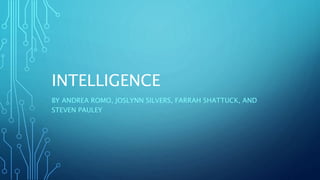
Intelligence
- 1. INTELLIGENCE BY ANDREA ROMO, JOSLYNN SILVERS, FARRAH SHATTUCK, AND STEVEN PAULEY
- 2. WHAT IS INTELLIGENCE? • Intelligence is the ability to solve problems and to adapt to and learn from experiences. • Intelligence was recently described as the ability to adapt to, shape, and select environments (Sternberg 2014)
- 3. CAN INTELLIGENCE BE MEASURED? • The Binet tests: intelligence quotient (IQ) tests that are used to refer to an individual’s mental age divided by chronological age, multiplied by 100. • Mental age (MA): individual’s level of mental development relative to others • This test can be given from age 2 through adulthood • The Wechsler Scales: does not test for IQ but it allows the examiner to quickly view the examinees strengths and weaknesses in different areas of intelligence. There are 3 scales. • The Wechsler Adult Intelligence scale • The Wechsler Intelligence test for children used for children and adolescents 6- 16 • The Wechsler Preschool and Primary Scale of Intelligence for children from 2yrs6m to 7yrs.7m
- 4. MULTIPLE INTELLIGENCES • Proposed by Howard Gardner • Verbal: think in words and use language to express meaning • Mathematical: carry out mathematical operations • Spatial: think three-dimensionally • Bodily-kinesthetic: manipulate objects and be physically adept • Musical: sensitivity to pitch, melody, rhythm and tone • Interpersonal: understand and effectively interact with others • Intrapersonal: the ability to understand one’s self • Naturalist: the ability to observe patterns in nature and understand natural and human- made systems
- 5. THE NEUROSCIENCE OF INTELLIGENCE • Researchers have found that a higher level of intelligence is linked to a distributed neural network in the frontal and parietal lobes. • The current consensus is that intelligence is likely to be distributed across brain regions.
- 6. INFLUENCE OF HEREDITY AND ENVIRONMENT • Genetic influences: researchers have found that there are more than 1,000 genes linked to intelligence, however, they have not been able to identify which specific genes contribute to intelligence • Environment: environmental experiences of children and adults do make a difference. In one study, it showed that the more the parents communicated with their children, the higher the IQ. • Schooling has also shown to positively affect IQ. i
- 7. GIFTEDNESS • People who are gifted have higher intelligence or superior talent of some kind. • An IQ of 130 is often used as the low threshold for giftedness • Though in earlier years it was thought that there was a connection between giftedness and emotional distress, no pattern has actually been identified.
- 8. CHARACTERISTICS OF CHILDREN WHO ARE GIFTED • Precocity: gifted children are precocious. They master an area earlier than their peers. They make it seem effortless. • Marching to their own drummer: they learn in a qualitative different way than from ordinary children. often, they make discoveries of their own and solve problems in a unique help. they need little to no help. • A passion to master: they are driven to understand the domain they have a high ability. they display an intense and obsessive interest and an ability to focus. • Giftedness is typically shown in one domain in specific
- 10. EDUCATION FOR THE GIFTED • Experts argue that education for the gifted needs a significant overhaul • Gifted children who are not challenges often become disruptive, skip classes, or lose interest. • Often, children who are gifted become socially isolated and underchallenged in the classroom. • Gifted adults often remember school as a negative experience; they were bored and often knew more than the teachers.
- 11. INTELLECTUAL DISABILITY • ID is a condition of limited mental ability in which the individual either has a low IQ (usually 70-), has difficulty adapting to the demands of every day life, and they exhibit these characteristics by age 18. • The low IQ and adaptiveness should be evident during childhood, not after normal functioning is interrupted by damage of some form.
- 12. • Organic intellectual disability: genetic disorder or a lower level of intellectual functioning caused by brain damage. i.e. fragile X syndrome. • Cultural-familial intellectual disability: when there is no evidence of brain damage. This type of disability often results from growing up in a below average intellectual environment. This type of disability can be identified at schools.